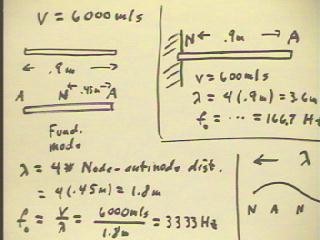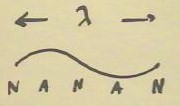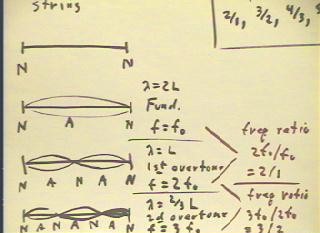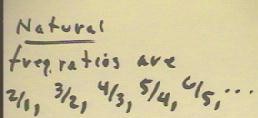"
Physics II
Class Notes, 2/12/99
A .9 m metal rod in which longitudinal pulses
travel with velocity 6000 m/s, supported by a magnetic field or
in free fall so that its vibrations are not damped, will
vibrat in such a way that the free endpoints will be antinodes.
- Between any two antinodes there must be a node, and for any situation
(such as this one) where the velocity of a pulse is constant the node-antinode
distance will be uniform.
- The fundamental mode of vibration will therefore have a node-antinode
distance of .45 m, as indicated.
- Since the wavelength is equal to 4 node-antinode distances, we
see that the wavelength of the fundamental mode must
therefore be 1.8 m.
- The frequency corresponding to this wavelength is
easily calculated.
By contrast, if one end of the rod is constrained to remain
stationary while the other end is free, the entire
length of the rod can consist of a node-antinode distance and
the fundamental wavelength will therefore be 3.6 meters.
- It follows that if we allow the rod to vibrate in response to transverse
disturbances, with a pulse velocity of 600 m/s, then the fundamental
frequency will be f0 = 600 m/s / 3.6 m = 166.7 Hz.

The figure below shows how a complete cycle of a harmonic wave
consists of four node-antinode pairs.

For a string fixed at both ends, both ends will
be nodes and the fundamental mode of vibration will
consist of these two nodes with an antinode in the middle
of the string.
- For this fundamental mode of vibration, the node-antinode
distance is 1/2 the length L of the string and hence the wavelength
of the fundamental will be 4 * (1/2 L) = 2 L.
- The fundamental frequency will be f0 = v / (2 L).
The first overtone, or the second harmonic, will
consist of four node-antinode pairs so that the wavelength will
be equal to the length of the string.
- The frequency of this overtone, which has half the wavelength
of the fundamental, will therefore be double the
frequency of the fundamental.
- We note that the frequency ratio from the first to the
second overtone is therefore 2/1.
The next overtone must contain an additional node-antinode
pair, so that the string contains 6 node-antinode distances and
the wavelength is therefore 2/3 L, which is 1/3 that
of the fundamental.
- The frequency of this overtone must therefore be 3 times that
of the fundamental.
- The frequency ratio between the first and second overtones is
therefore 3/2.

This pattern continues, adding a node-antinode pair for
every subsequent harmonic.
- The natural frequency ratios of a string are therefore found to be 2/1,
3/2, 4/3, 5/4, 6/5, etc..
- The frequency ratio of harmonic # n+1 to that of harmonic
# n is therefore f(n+1) / f(n) = (n+1) / n.

The ratios for a vibrating rod or air column for
which one end is a node and the other an
antinode can be easily found to be 3/1, 5/3, 7/5, etc..
- These ratios can be found in a vibrating string, with the 3/1 ratio
being the ratio between the third harmonic and the fundamental,
and the 5/3 ratio found between the fifth and third
harmonics.
On a keyboard, a doubling of frequency (an
'octave'), is achieved in 12 steps, with each key (white
or black) having a frequency r = 2^(1/12) = 1.05946 (approx.) higher than
the one to its left.
- For example, the natural 5/4 = 1.25 ratio is approximated by
four of these 'steps', which gives us the ratio
1.05946 ^ 4 = 1.26 (approx.).
- This ratio corresponds to an interval of a 'major
third', in music terminology.
- The 3/2 and 4/3 ratios are approximated very
closely by the 7th and 5th powers of 2^(1/2), and correspond to the intervals
of a 'perfect fifth' and a 'perfect fourth' in
music terminology.
- The 6/5 ratio is also approximated, this time by the 3d power of
the fundamental ratio, and corresponds to the interval of a 'minor
third'.
- All these intervals, when heard, have sounds that we tend to find pleasing
and 'harmonic'; we can identify any of these
intervals with a familiar tune.
- The interval obtained by 'splitting' the 12-interval octave into
two equal ratios of 1.05946^6 generally do not
sound pleasing or 'harmonic'. This interval is called a 'tritone', and
does not approximate any natural mode of vibration with
which we are generally familiar. We therefore say that the tritone is an 'unnatural'
interval.

"
